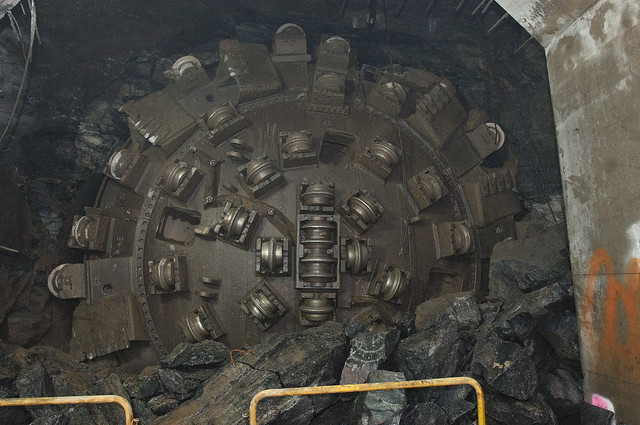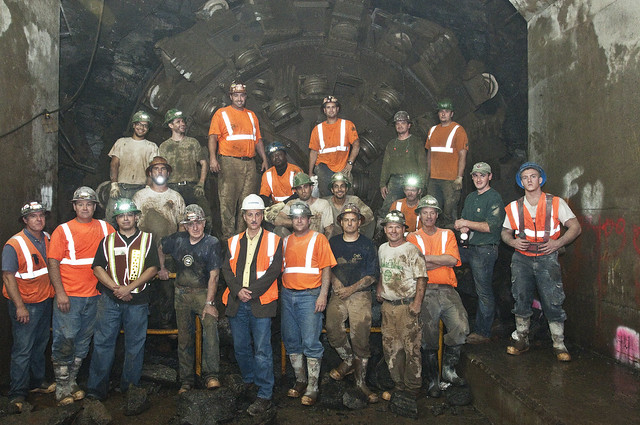During my Thanksgiving sabbatical from blogging, news come down from on high that blasting underneath Second Ave. would cease temporarily as the MTA and its contractors work to mitigate the impact of the construction. For a project that has plowed ahead while often barely considering the impact the immediate would have on the locals, this decision to reassess the situation both below and above ground is not a small one for a project on a timeline with little margin for error.
The New York Times reported on the decision last week. Per Christine Haughney and Michael Grynbaum, the MTA has issued a two-week moratorium on blasting as it works to modify the exhaust systems and giant enclosures that are supposed to trap debris. Blasting will resume on December 5, and residents are thrilled with the decision.
Those Upper East Siders who spoke with reporters were concerned with the long-term impact such blasting would have on their health. “I don’t want it to turn into a 9/11 situation where, five to 10 years down the line we’re sick,” Donna Pressman said to Pete Donohue of The Daily News. Said Jean Schoenberger to The Times. “It’s like gun powder that is going up in the air. It is a smoke cloud that is very pervasive.”
So while it’s all well and good that the MTA is responding to community complaints and hosting a quarterly public workshop on construction progress this Wednesday, there’s another side to this story as well. As Carolyn Maloney, the Congressional representative whose constituents include Upper East Siders, said of the long-awaited subway, “The best thing to do is to finish it.”
Thus, as Christine Haughney wrote last week, a faction of Upper East Siders would prefer to see the MTA just finish the damn thing already. She reported:
Francisco R. Quijada and Gus Sofronia, both longtime business owners along Second Avenue, know how frustrating the construction of the new subway line can be. Both have watched their businesses suffer from the huge enclosures that have been built in front of their buildings. And both have asked customers to ignore the steady drilling and hammering that emanate from beneath their feet. But when the Metropolitan Transportation Authority decided on Tuesday to stop temporarily the blasts it had been conducting around East 72nd Street each afternoon to try to better contain the dust billowing up, the two men reacted very differently.
Mr. Quijada, 79, an interior designer who has had his studio on Second Avenue near 72nd Street for 45 years, welcomed a break from the thunderous booms. They rattle his studio, riddle his walls with cracks and send dust into his front window display like sand pouring down an hourglass, he said. When he looks outside after a blast, he said, he sees passers-by covered in dust. “It sounds like another bomb is coming,” he said. “Maybe for somebody in their 20s, it would be exciting for it to happen. We have lost a lot of business.”
Mr. Sofronia, owner of Cafe Greco on Second Avenue near 72nd Street for 25 years, also says that the booms have hurt his business. But he is angry that the Second Avenue project has slowed. He wants the authority to wrap up its work so he can start making money from customers riding the new line. “That’s just delaying the project; you can’t have construction without dust,” Mr. Sofronia said. “As a business owner, I don’t really care about dust. If people start nagging about everything, this is going to be done in 2030.”
That is, of course, the ongoing battle. When Phase 1 of the Second Ave. Subway is completed, the Upper East Side will be a far more accessible area, and property values and business will jump. I’ve often wondered, in fact, if investing in the area around Second Ave. now while prices are depressed would constitute a sound investment. As long as the MTA finishes Phase 1 somewhat on time, I’d think it is.
But on the other hand, people have to live within this construction zone for another five years. The MTA is building a subway through a densely populated urban area with decades or centuries of uncharted and ill-maintained infrastructure, and it’s no easy task to do so without disrupting every day life. Without adequately stable buildings, without thorough maps of the underground scene, the MTA is flying blind.
Ultimately, just finishing it would be the best thing for the Upper East Side. Unfortunately, though, even the best case scenario means five more years of construction, some more invasive than others. For now, the MTA must strike a balance between moving forward and placating neighbors who want a subway line but don’t want the headaches, dust and debris that comes with it. As the fun starts up again on December 5, that gives the agency just one more week to address the problems.


 Late last week, MTA honchos and various elected officials gathered underground at 63rd St. to celebrate the
Late last week, MTA honchos and various elected officials gathered underground at 63rd St. to celebrate the 

 I took the Q back from Manhattan to Brooklyn in the middle of the afternoon yesterday. Because it was an off-peak train and the MTA is doing some work north of 57th St., the Q train turned around at 57th St. I boarded a train on the downtown express tracks, and what happened next was something sort of silly.
I took the Q back from Manhattan to Brooklyn in the middle of the afternoon yesterday. Because it was an off-peak train and the MTA is doing some work north of 57th St., the Q train turned around at 57th St. I boarded a train on the downtown express tracks, and what happened next was something sort of silly.